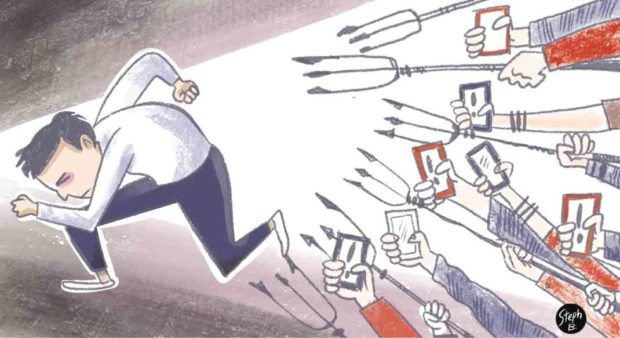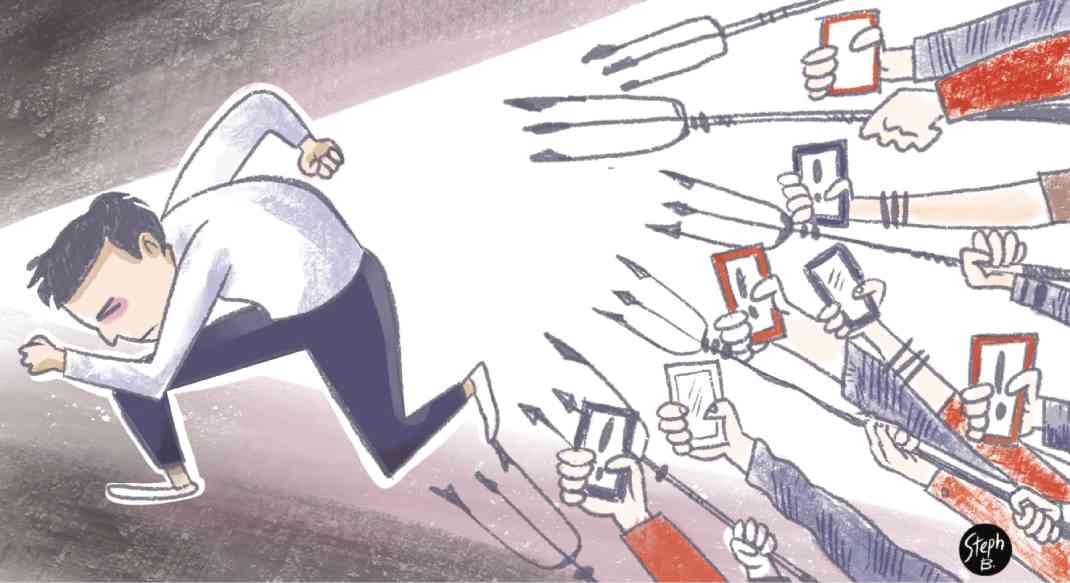
Each morning I get up thinking that if this day were my final one, that’d be just fine. I know that the world will still be spinning 30 seconds after I’m gone, and there’s somewhere else I’d rather be. Well, I’m definitely not doing that part myself, but maybe today will be my lucky day. Maybe today, the world will hear me whisper. I hope that the people closest to me know it’s not their fault.”
“A day in the life of a passively suicidal individual,” of which the above paragraph is a part, is an essay posted on the online publishing platform medium.com in July 2018.
Despite its dark and downbeat tone, the piece ended on a relatively hopeful note:
“I do not have it in me to carry on, but I will. Until my day comes, the world is turning, and there are things I can do to make it better. And so long as I’m still here, I’m never giving in.”
Knowing that the author, a student at the University of the Philippines, did eventually give in, choosing to end his life, the words sound chillingly prescient.
The death of a young man who seemed so full of promise is a tragedy, and always begs the question: What drove him to it?
If one were to base one’s conclusions solely on the shifting narratives of the Twitterverse, it took less than a week for his life to unravel.
An activist, honor student, member of several campus organizations including Sigma Rho, a fraternity based in the UP College of Law, he seemed to be living an active, socially engaged life.
His troubles began when screenshots of a two-year-old chat between members of Sigma Rho were posted anonymously online. The post included a photograph of the young man holding a paddle—an implement traditionally used in fraternity initiation rites, and a photograph of another student, presumably a neophyte, with dark bruises on his arms.
Within a few hours, the post went viral.
Hazing deaths
At the time, the campus was already in an uproar over fraternity hazing in the wake of the death of Philippine Military Academy cadet Darwin Dormitorio.
The university had its own history of hazing deaths among its Greek-letter societies going back to the 1950s, as well as the more common inter-fraternity “rumbles.” The school’s frat-boy subculture was already under fire since another online scandal the year before, when similar chats by a different fraternity were leaked, revealing some members—to no one’s surprise—to be misogynistic, homophobic, crude and violent.
The fallout from the viral posts was swift and merciless. Within the day, student organizations were releasing statements condemning fraternity-related violence or “FRV” in internet shorthand.
The next day, a letter of complaint against the young man was filed by a fellow officer of the college student council to which he belonged. Citing the viral Twitter post, the letter charged him with “grave misconduct and violence” and requested an immediate trial.
“It is important that the integrity of the student council be maintained, and having an officer who performs violence is contrary to that,” the letter said.
The young man was placed under preventive suspension, pending a trial. He was given the option of making a privilege speech or submitting a written statement to air his side during an emergency meeting of the student council.
That would never happen.
By early afternoon the next day, he was found dead, having apparently taken his own life.
The next day, UP Diliman Chancellor Michael Tan issued the following statement:
Dramatic shift
“I appeal to all students, faculty and staff, as well as other concerned parties in and out of UP Diliman, to stop posting and forwarding social media messages related to the death of one of the Sigma Rho fraternity members implicated in last week’s online exposé of the fraternity’s hazing. Let us do this out of a sense of decency and respect for the privacy of the family.”
Floodgates, however, once open are not so easily shut. The tone of the emerging narrative pieced together from tweets, posts and comments, shifted dramatically.
After the leak of the Sigma Rho screenshots, posts and comments in the Twitterverse were overwhelmingly condemnatory. Some online observers likened it to “a social media lynch mob.”
But after news of the young man’s suicide broke, the condemners were themselves condemned. Online posts were hurriedly deleted as tributes and eulogies to the departed poured in, while accusations of cyberbullying and worse were hurled at his critics.
In a rare moment of introspection, online observers noted the emergence of “call-out culture” and the mob mentality that was so swift to condemn the young man, and just as swift to absolve him, seemingly without bothering to separate fact from conjecture, or frankly, even put much thought into their reactions.
Real people
Writer Katrina Stuart Santiago characterized the online discourse leading up to and following his suicide as “a very depressing black hole.”
“The noise of groups and the social media mob, demanding quick action and condemnation, there is a downside to that. There is a massive problem with that, specially when we’re talking about private individuals, about REAL PEOPLE.
“A question: Where was hunos-dili in this case? When even the institutions did not practice restraint, did not take some time to put things in perspective, did not even ask questions about the possibility that these kids don’t even believe what they believed two years ago. When institutions are at the mercy of mob rule—who then is in control?”
In a separate comment two days after the suicide, she wrote: “We need to take responsibility for this death. We need to flesh out a timeline where we see how screencaps from an anonymous account, without dates and curated to fit a narrative, were enough for a student to be shamed on social media, where calls for accountability quickly and expectedly spiraled down to bullying and harassment, mob rule and kuyog, with personalities ranging from student activists to non-activists, student council peers and college friends joining the fray. The fall from grace was less than a week. Social media kicked him dead.”
In a statement, alumni of the young man’s fraternity said: “Sigma Rho deeply mourns the loss of a dedicated brod who was called out, condemned, and shamed without even being heard.”
Of course, it is now difficult, if not impossible, to know with certainty whether that is really the case. Much of the online vitriol following the leak has been deleted and in any case we don’t really know if the young man read any of it, much less how he felt about it.
Mental health
One aspect of this tragedy that has largely been overlooked is the mental health angle. The young man’s medium.com essay suggests he was no stranger to suicidal ideation.
“I just cannot find lasting meaning in the breaths I am taking,” he wrote. “When I dream of drowning in an ice cold lake, the saddest part is always waking up in the morning. It’s a mixture of the feeling of not belonging anywhere, and the disillusionment at everything wrong I’ve seen in this f—ed up world. I just don’t want to be here anymore. I know I’d be happy literally anywhere else. Moments when I feel like I actually want to stay for the long haul are few and far between. If in the middle of a thunderstorm, a stray bolt were to strike me, I say why not?”
One should be wary of reading too much into the essay, written more than a year ago, possibly in the aftermath of a “dark night of the soul,” a bout of existential world-weariness.
It is all too easy to imagine the words describing how the young man felt just before he went over the edge.
In an unrelated interview on how Philippine schools are dealing with the upsurge in mental health issues among students, Dr. Dinah Nadera, resident psychiatrist at UP’s Health Services, cautions against blaming social media alone for causing acute mental distress or depression.
“You cannot point to it as the only cause,” she says. “People would have been predisposed already, and social media triggers depressive or anxiety symptoms. Youth in general now want to do a lot of things, information is overwhelming, and yet we see many of them don’t read instructions, students in particular, and later on they start comparing themselves with other people they see on social media, and they’re not critical about whether the posts are true or not. They get a lot of information but they’re not able to process that much information.
“They are placed in situations where it seems they have so many possibilities, so many options,” she continues.
“They need constant assurance, approval. They are also pressured to excel, and the pressure is no longer coming from outside, but from themselves.”
Apart from Nadera’s clinic at the UP Health Services, the university also offers counseling and therapy through its Psychological Services program. But quite often, it’s not easy for students in distress to ask for help.
“It’s the same effect with an individual who has a thousand friends on social media, pero iilan lang ang malalim,” says Gary Faustino, head of the Office of Guidance and Counseling of Ateneo de Manila University.
“In theory and practice, if you are not able to disclose or relate to someone on a gut level, feelings included, it’s a very superficial relationship. When that happens, then you are detached, and when you need someone to turn to, you probably have no one with you. And that creates a lot of emotional downturns.
“School can add to the stress,” he adds. “The challenges of exams, schedules, submission of reports. It’s what we call a perfect storm. Some of them are very competitive, joining three or four orgs. Complicated na ang academics, sasamahan mo pa ng organizations, pag tinamaan ka mabigat.”
With hindsight, it is tempting to fit the young man into a psychological profile, but that would be reductive, just like the social media mobs that first condemned him and then eulogized him after it was already too late.
No one can really know for certain what drove him to his lonesome death, and that is the real tragedy here.









































